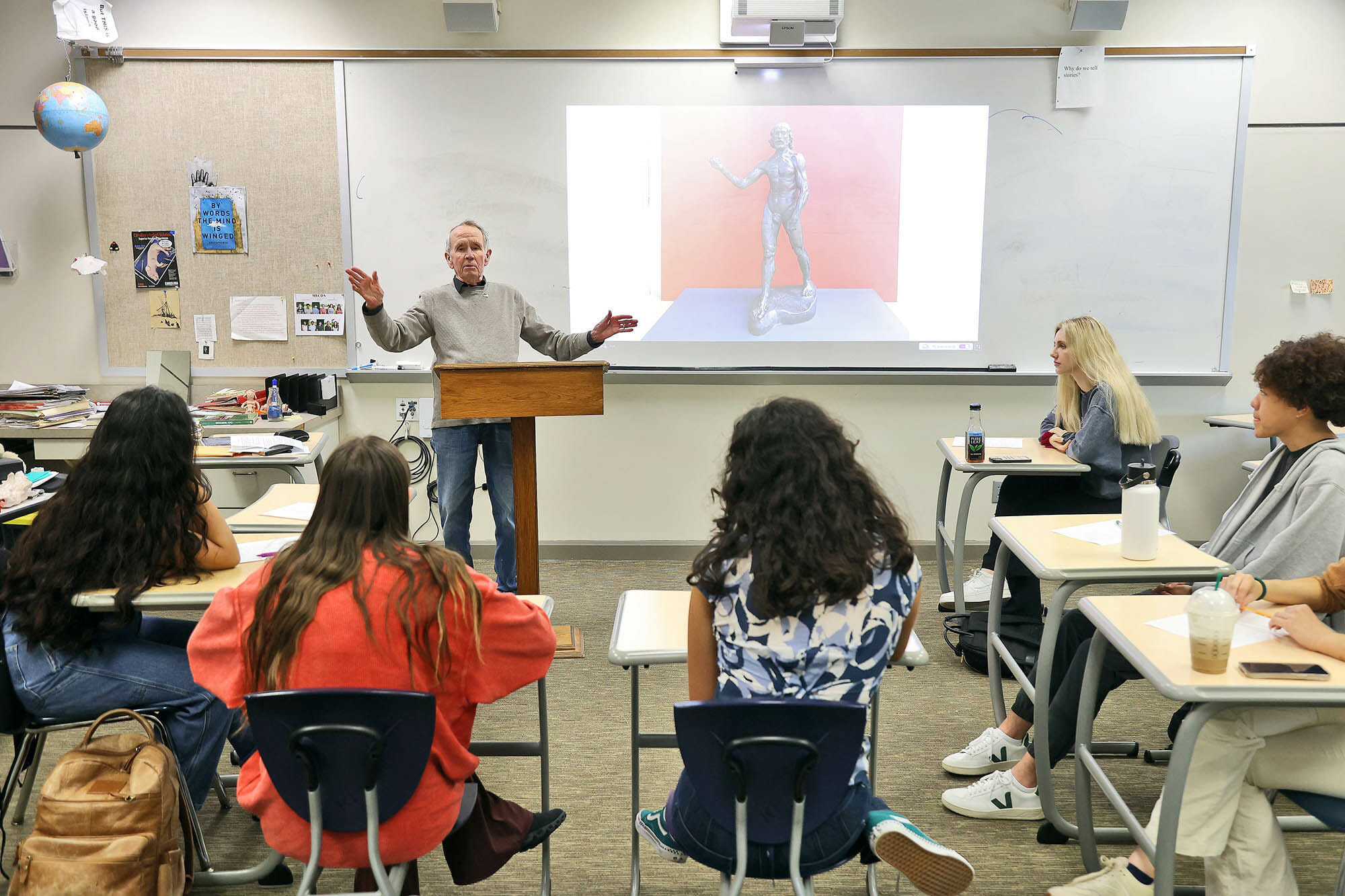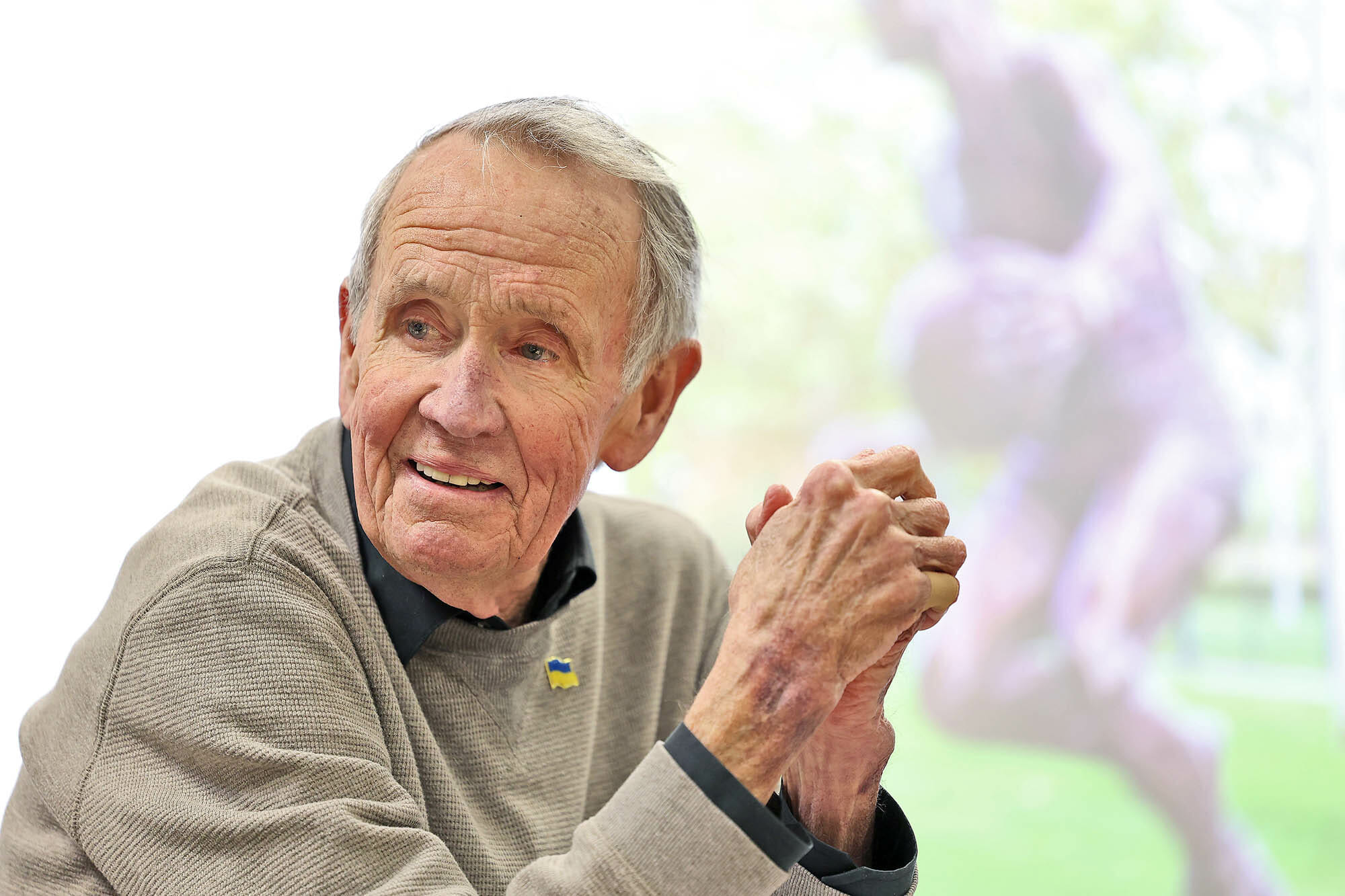Upper School English Teacher Chris Rappleye’s Advanced Literary Topics: Creativity class had a special guest speaker last week: artist, alumnus, and former MICDS Arts Teacher Harry Weber ’60 stopped by to talk about his career, art, and creativity in general.
The seniors have been studying the elements of creativity all semester. Creativity is consistently ranked as a highly-valued trait in our culture but is also regarded with suspicion, and creative people frequently find themselves at odds with their society and its expectations. It can be a means of changing minds, developing insights, and producing new emotional relationships with the world. Creativity and creative projects are sometimes challenged and even condemned; creativity can be “dangerous” and is often subject to social controls. The class examines the psychology of creativity and views creative people in the context of their societies, finishing the semester with a substantive creative writing portfolio and a reflection upon their own creative process.
« Harry Weber’s work is represented in over half the United States and as far afield as the Bahamas and West Africa. And yet, if you’ve spent any time in Saint Louis at all you are no doubt familiar with it already, whether it is his sculpture of Dred and Harriet Scott next to the old courthouse commemorating the disastrous « Dred Scott decision » and their courage in facing injustice—a commission awarded in a blind juried competition, the memorial of Lewis and Clark’s return on the waterfront near the Arch, the noteworthy St. Louis Cardinals captured in action for posterity outside of Busch Stadium or the figures here on campus outside of Olson Hall, » said Rappleye when introducing Weber to the class.
Weber is a graduate of St. Louis Country Day School, attended Princeton University, and served his country in Viet Nam. From his days at CDS, Weber was a drawer, eventually taking his sketchbook into war to capture his colleagues in action. This artistic impulse eventually led to his becoming a renowned sculptor.
« Harry, like some of the artists we have studied this year, is a public artist whose work can be found on the street, but his work is different from the street artists we’ve been hearing about, » said Rappleye. « Harry and his team work with commissioned art that will typically be displayed in public for public consumption. »
Weber eagerly shared memories and photos of his work with the students, along with his thoughts about creativity. He said that there are two things he considers when judging whether something is art: does it make an immediate emotional impact when you see it, and can you automatically see the facility of the artist who made it? « You have to pay your dues, » he said. « Every mark is the result of thousands of hours of practice. »
Weber has been drawing since he was four years old, and something he feels compelled to do at all times. He carries a sketchbook everywhere he goes, and he loves to study humans. « There are 670 muscles in the human face, » he said. « So you can tell what someone is thinking. The face is exquisite. The body is movement. »
He advised that there are three legs to « making it » as an artist: Eighty percent is practice. Weber says you have to just keep making art to get better at it. « You have to practice it so long that the right brain takes over and your actions become automatic. It happens! » he said. Ten percent is talent, and ten percent is blind luck.
Sculptures all over the United States speak to Weber’s ongoing artistry. From Bobby Orr in Boston to Bill Bradley at Princeton, Daniel Boone in St. Charles, a Stan Musial statue showing the legend signing an autograph for a small fan, Lou Brock making a slide at Lindenwood University, Buck O’Neil in Kansas City, and Cool Papa Bell, Dizzy Dean, Bob Gibson, and Chuck Berry around St. Louis. He has spent his career portraying larger-than-life figures in bronze and stainless steel.
Students asked a variety of questions, and Weber answered them all. He said it’s fine to take poetic license in art so long as the proportions look right. Three-dimensional art is easier than two-dimensional if you’re a representational artist. Why does he keep doing art? « Other people’s money, » he answered with a smile, causing the students to erupt in laughter. He has certain conditions for his work; for example, he will only present to one person, never a committee. « There’s nothing more deadly to artwork on earth than a committee, » he said. It takes him nine months to a year to make a single figure. He employs about 10 people for every piece, including the mold maker, the foundryman, and « the guy who drives the truck. » He’s 80 years old now, and he admits that it took him a long time be able to charge enough to make a decent wage.
Perhaps the best advice Weber imparted is to be observant and curious. « I love looking at people and how they deal with gravity. It’s fascinating, » he said. « I see movement wherever I go. Even in a gentle tip of the hat. »
« Harry Weber’s work in bronze is particularly distinguished for its ability to capture motion, a sense of animation in solid metal…there is always a sense of life in his work, » said Rappleye.
Thank you, Mr. Weber, for spending your valuable time with our students. We can’t wait to see what you create next!









